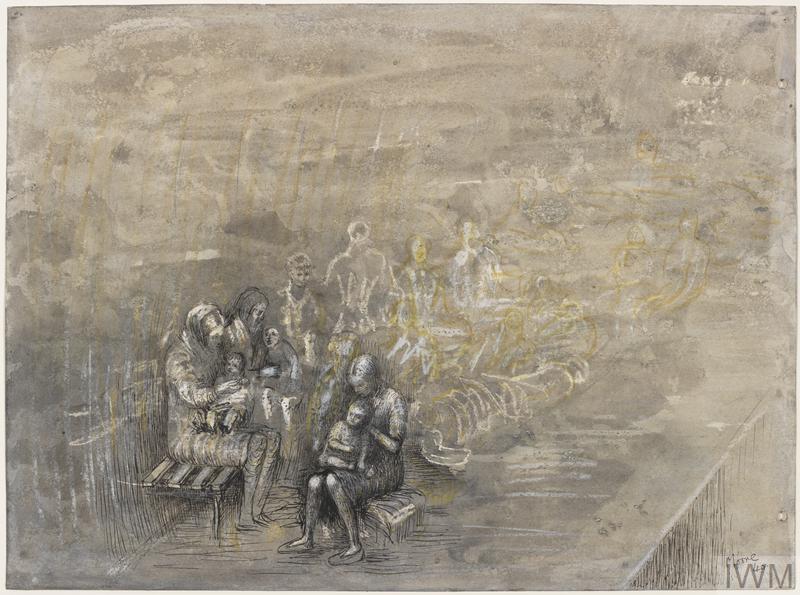It would be an understatement to say that war heavily affects the society and culture of the surrounding and involved areas and groups. From books to politics to food to paintings, the bloodied claws of war dig into every aspect of life and stain them red, leaving scars and wounds that can't be erased. Some of the most visually affected aspects touched by war are the arts. When war breaks out, there are almost always artists who bring out their easels and brushes, their charcoals and inks, and get to work. Whether to cope or to simply document the violence and turmoil around them, these artists have created visual evidence that has stood the test of time, allowing us in the modern day a glimpse into these darkened parts of history.Some of the most prominent and well-known tend to be art of revolutions specifically, with various pictures appearing alongside the text in our history books. While it's easy to overlook these works as mere depictions of violence, I believe it would be a shame to the artists to not find the beauty in the gunpowder-tainted brushstrokes.

The Storming of Bastille, 1790, Jean-Baptiste Lallemand
Born in Dijon, France, in the year 1716, Lallemand spent most of his career in Italy under commision by the Pope. When he returned to France in the 1760s, the revolution was just beginning to brew. As tensions grew, Lallemand was there to witness it all, and by the time they boiled over into the infamous event we recall today in July of 1789, he decided to capture the events on to canvas. The piece above shows the storming of the Bastille, a symbol of power under the Ancien Regime. The castle starts off with soft, bright lighting to the left, but grows shaded towards the middle, as if to represent the aristocracy's defeat. Similarly, the revolutionaries are marching out of a darkened portion of the canvas and into the light, invoking a feeling of victory in the viewer. This makes sense as Lallemand was on the side of the French people, and supported the goals of the revolutionaries. He also notably did not include any specific focal characters or 'protagonists', as he did not want to fantasize or create a narrative over the importance of the event, instead choosing to emphasize how this moment might have looked from the perspective of the people.

Declaration of the Rights of Man and of the Citizen, 1789, Jean-Jacques-Francois le Barbier
Born in 1738, Le Barbier was actually a well-known painter under both the Ancien Regime and the revolutionaries. He managed to avoid the ridicule and eventual assassinations of the rest of the regime by adjusting the subject matter of his works to be pro-revolution. Take, for example, his painting Declaration of the Rights of Man and of the Citizen, depicting a stylized version of the document of the same name created by the new National Assembly in 1789. The painting uses fluid brushstrokes and gentle colours, leading to a feeling of hope and warmth. The lettering is impressive as well, with clean line work and intelligible writing. The rays of light at the top of the painting invoke a sense of holiness, as though the revolution was a righteous act. The entire painting really puts into perspective how important the French Revolutionaries believed this document to be, as they not only wrote it down on paper, but immortalized it on canvas.

The Battle of Bunker Hill, June 17, 1775, 1789, John Trumbull
The Battle of Bunker Hill, June 17, 1775 by John Trumbull takes a harsh departure from the previous paintings themes of hope and victory, displaying a scene of loss and violence. Completed in 1789, the painting depicts the first major battle of the Revolutionary War, the battle at Breed's Hill. The central focus of the painting is the death of Dr. Joseph Warren, the position of his lifeless corpse in his comrade's arms reminiscent of depictions of Christ being removed from the cross. Warren was the first martyr of the Revolution, which explains why this work was the first in Trumbull's series of paintings focused around the American Revolution. The paint is somewhat hazy in certain spots, giving the effect of smoke or gunpowder fogging the view, with light focusing on Warren and the Patriots as if to illuminate the heroes, at least from the perspective of the Americans. By having heavy shading in other areas of the painting and saving the lighter areas for Warren, it directs the viewer's eye to the dying patriot. This then guides us to another detail by following the lines of the bayonet above Warren, revealing British Major John Small preventing a British officer from stabbing the fallen Patriot, a small act of humanity amidst the chaos and bloodshed of war.
Information Sourced From:





The Battle of Bunker Hill painting by John Trumbull appeals to me because it portrays intense emotion, loss, and heroism. I related to your observation of the similarities between Jesus being removed from the cross and this painting. I also noticed the use of lighting and shading to direct the viewer's eye to the central figure of Dr. Joseph Warren, who is depicted as a martyr for the American Revolution. I like how you discussed how artists depicted key moments of the French and American Revolutions through their paintings. And how you highlighted the importance of these artworks as visual evidence of historical events and as a way to evoke emotions and ideas about these revolutionary periods.
ReplyDelete